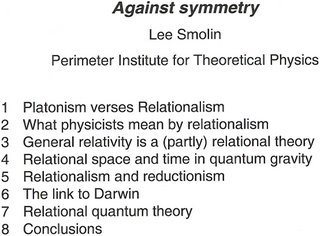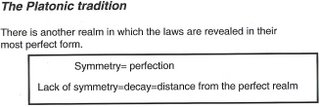The Nobel Prize in Physics 1914 Max von Laue
I am not sure what I can add other then what I have already been saying toward logical deduction....I still need to get a handle on the essence of what is being said here in opening thread.
So with what I looked at, can we say that the deductive recognition of lets say symmetry would be in contrast to how you might look at the world in a relativistic sense versus Platonism.
See:
Against Symmetry
This setting was used more I think in terms of how a scientist is explaining himself and his relationship with the way in which he had approached science.....yet I could see there were scientist who had adopted the Platonic Tradition. Example of
Penrose and
Coxeter were demonstrative of this idea?
Platonism is a family of views that get their name because they involve entities--propositions, properties, sets--which, like Plato's Forms, are held to be abstract, immutable things that exist outside space and time. On many platonistic approaches, concepts express abstract properties and beliefs are relations between people and abstract propositions. This suggests a way around some types of relativism, since people in quite different cultures could have many of the same beliefs (because they could believe the same abstract propositions), and a belief would be true just in case the immutable proposition it expresses is true.
The relativist may reply that platonistic accounts lead to severe difficulties in epistemology and semantics. The problem is that we are physical organisms living in a spatio-temporal world, and we cannot interact causally (or in any other discernible way) with abstract, causally inert things. Moreover, few people are aware of having any special cognitive faculty that puts them in touch with a timeless realm of abstract objects, neuroscientists have never found any part of the brain that subserves such an ability, such a view is not suggested by what is known about the ways children acquire concepts and beliefs, and nothing in physics suggests any way in which a physical system (the brain) can make any sort of contact with causally inert, non-physical objects. Moreover, if our minds cannot make epistemic contact with such things, it is difficult to see how our words and linguistic practices can make semantic contact with them.
None of this proves that abstract propositions don't exist, but it shows it isn't obvious that they do. There have been few debates between relativists and platonists over such matters, however, perhaps because the two views lie so far apart that their proponents cannot easily engage one another.
So these were two positions that were adopted within the push toward understanding the basis of science and it's mathematics.
In theory model development was pushed forward on the basis of such adoptions. Loop Quantum Gravity?
Quasicrystal: Prof. Dan Shechtman
***
Just throwing some stuff together in order to understand the extent of relativism as a universal truth, while seeking to understand the subjective realism that make up our individuality. As a layman I do not know if it will be useful under that admittance. You can judge for yourself of course.
Most people think of "seeing" and "observing" directly with their senses. But for physicists, these words refer to much more indirect measurements involving a train of theoretical logic by which we can interpret what is "seen."- Lisa Randall
If one was to solidify some basis to truth how would this be done? The question of a logic oriented view for me saw a basis in what Penrose was explaining using his Twistors, as a foundation in incorporating Fuzzy logic?
While examining the psychological model of
Venn logic and TA combined, it was important that there be some relative framework for such a subjective interpretation of a logic orientated world. How subjectively could this have been managed?
Perspective of the Theoretical Scientist
So you have this history and theoretical perspective that sees the world in one way or another? How do you reduce it to a process through Computing that establishes a basis in machining the effects of [
and\or-so that we say a statement is .7 true and .3 false.]? We've created a space in between a true and false statement?
DNA computing is a form of computing which uses DNA, biochemistry and molecular biology, instead of the traditional silicon-based computer technologies. DNA computing, or, more generally, molecular computing, is a fast developing interdisciplinary area. Research and development in this area concerns theory, experiments and applications of DNA computing See:DNA computing
Entanglement then provides for other understanding then of a framework that sees the interrogation of a subjective world?
Do we selectively ignore other models from artificial intelligence such as Zadeh's Fuzzy Logic? This is a logic used to model perception and used in newly designed "smart" cameras. Where standard logic must give a true or false value to every proposition, fuzzy logic assigns a certainty value between zero and one to each of the propositions, so that we say a statement is .7 true and .3 false. Is this theory selectively ignored to support our theories? Ideas on Quantum Interrogation
***
Geometry Leads us to the Truth?
Part of the realism here for me is the idea that such patterns established deep within our psyche are inherent in each of us as an image first to our awareness, but encompasses a geometric patten of sorts. This was part of the work I did on myself as I explored the realm of dreams. The idea then manifested in what was the basis of this thought process as mandala in origins. A historical vision of an ancient idea of model building. In today's world I thought this as appropriate toward how theoretical ideas are built around a whole history of science and information.















